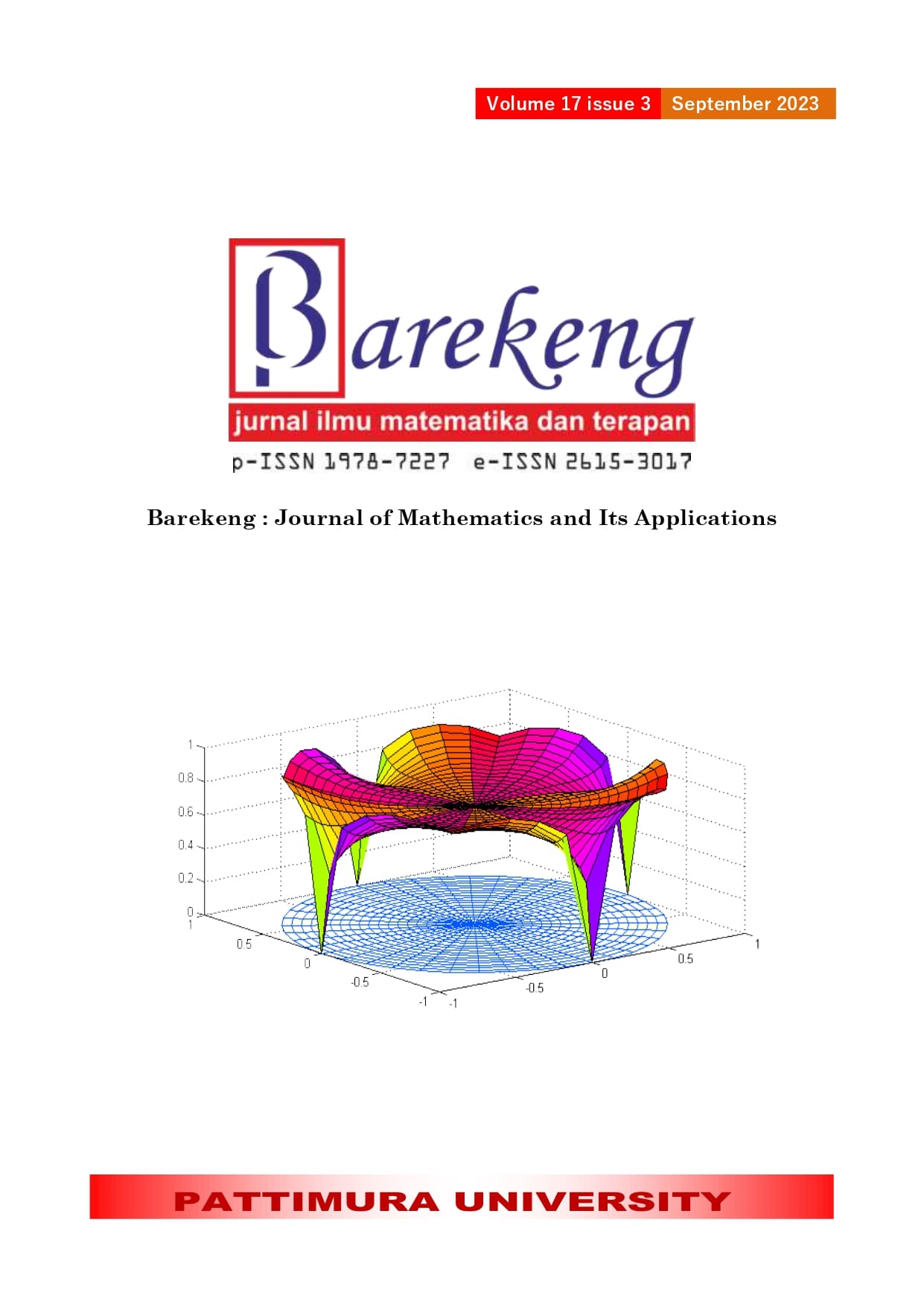COMPARISON OF SEASONAL TIME SERIES FORECASTING USING SARIMA AND HOLT WINTER’S EXPONENTIAL SMOOTHING (CASE STUDY: WEST SUMATRA EXPORT DATA)
Abstract
Export is the activity of selling goods or services from one country to another. This activity usually occurs in a specific region or country. Export data is a type of data that has a seasonal pattern. This study aims to compare SARIMA and Holt Winter’s methods in forecasting export data. In this study, the SARIMA model ((1,1,1) (0,1,1))12 and Holt Winter's simulation were obtained. The data used is the export data of West Sumatra from 2016 to 2022. The best model is the one with the smallest MAPE or MAD. The SARIMA model yielded a MAPE of 0,437% and MAD of 78,821. Meanwhile, the Holt Winter's method yielded a MAPE of 0,894% and MAD of 163,320 with α=0,2, β=0,5, γ=0,1. Therefore, the SARIMA outperformed the Holt Winter’s method due to its higher accuracy. It can be concluded that the SARIMA is suitable to use as the forecasting model in this case. In this study, forecast have been made for the next 24 periods, from January 2023 to December 2024.
Downloads
References
L. C. Ortigueira-Sánchez, D. H. . Welsh, and W. C. Stein, “Innovation drivers for export performance,” Sustain. Technol. Entrep., vol. 1, no. 2, p. 100013, 2022, doi: 10.1016/j.stae.2022.100013.
O. Malca, J. Peña-Vinces, and F. J. Acedo, “Export promotion programmes as export performance catalysts for SMEs: insights from an emerging economy,” Small Bus. Econ., vol. 55, no. 3, pp. 831–851, 2020, doi: 10.1007/s11187-019-00185-2.
E. Z. Martinez, E. A. S. da Silva, and A. L. dal Fabbro, “A SARIMA forecasting model to predict the number of cases of dengue in Campinas, State of São Paulo, Brazil | Um modelo SARIMA para predição do número de casos de dengue em Campinas, Estado de São Paulo,” Rev. Soc. Bras. Med. Trop., vol. 44, no. 4, pp. 436–440, 2011, doi: 10.1590/S0037-86822011000400007.
M. Olsson and L. Söder, “Modeling real-time balancing power market prices using combined SARIMA and Markov processes,” IEEE Trans. Power Syst., vol. 23, no. 2, pp. 443–450, 2008, doi: 10.1109/TPWRS.2008.920046.
L. Ferbar Tratar and E. Strmčnik, “The comparison of Holt-Winters method and Multiple regression method: A case study,” Energy, vol. 109, pp. 266–276, 2016, doi: 10.1016/j.energy.2016.04.115.
G. A. N. Pongdatu and Y. H. Putra, “Seasonal Time Series Forecasting using SARIMA and Holt Winter’s Exponential Smoothing,” IOP Conf. Ser. Mater. Sci. Eng., vol. 407, no. 1, 2018, doi: 10.1088/1757-899X/407/1/012153.
G. R. Alonso Brito, A. Rivero Villaverde, A. Lau Quan, and M. E. Ruíz Pérez, “Comparison between SARIMA and Holt–Winters models for forecasting monthly streamflow in the western region of Cuba,” SN Appl. Sci., vol. 3, no. 6, 2021, doi: 10.1007/s42452-021-04667-5.
A. Kumar Dubey, A. Kumar, V. García-Díaz, A. Kumar Sharma, and K. Kanhaiya, “Study and analysis of SARIMA and LSTM in forecasting time series data,” Sustain. Energy Technol. Assessments, vol. 47, no. May, p. 101474, 2021, doi: 10.1016/j.seta.2021.101474.
M. Milenković, L. Švadlenka, V. Melichar, N. Bojović, and Z. Avramović, “SARIMA modelling approach for railway passenger flow forecasting,” Transport, vol. 33, no. 5, pp. 1113–1120, 2018, doi: 10.3846/16484142.2016.1139623.
H. A. Mombeni, S. Rezaei, S. Nadarajah, and M. Emami, “Estimation of Water Demand in Iran Based on SARIMA Models,” Environ. Model. Assess., vol. 18, no. 5, pp. 559–565, 2013, doi: 10.1007/s10666-013-9364-4.
Q. Sun, J. Wan, and S. Liu, “Estimation of Sea Level Variability in the China Sea and Its Vicinity Using the SARIMA and LSTM Models,” IEEE J. Sel. Top. Appl. Earth Obs. Remote Sens., vol. 13, pp. 3317–3326, 2020, doi: 10.1109/JSTARS.2020.2997817.
M. Haddad et al., “Wind and Solar Forecasting for Renewable Energy System using SARIMA-based Model To cite this version : HAL Id : hal-02867736 Wind and Solar Forecasting for Renewable Energy System using SARIMA-based Model,” 2020.
L. M. B. Ventura, F. de Oliveira Pinto, L. M. Soares, A. S. Luna, and A. Gioda, “Forecast of daily PM 2.5 concentrations applying artificial neural networks and Holt–Winters models,” Air Qual. Atmos. Heal., vol. 12, no. 3, pp. 317–325, 2019, doi: 10.1007/s11869-018-00660-x.
A. Zemkoho, “MATH6011 : Forecasting,” Sch. Math., 2018.
P. Kalekar, “Time series forecasting using Holt-Winters exponential smoothing,” Kanwal Rekhi Sch. Inf. Technol., no. 04329008, pp. 1–13, 2004, [Online]. Available: http://www.it.iitb.ac.in/~praj/acads/seminar/04329008_ExponentialSmoothing.pdf.
A. Wibowo, “Model Peramalan Indeks Harga Konsumen Kota Palangka Raya Menggunakan Seasonal ARIMA (SARIMA) Forecasting Model for Consumer Price Index of Palangka Raya City using Seasonal ARIMA (SARIMA) Ananto Wibowo,” J. Mat., vol. 17, no. 2, pp. 17–24, 2018.
Copyright (c) 2023 Lilis Harianti Hasibuan, Syarto Musthofa, Darvi Mailisa Putri, Miftahul Jannah

This work is licensed under a Creative Commons Attribution-ShareAlike 4.0 International License.
Authors who publish with this Journal agree to the following terms:
- Author retain copyright and grant the journal right of first publication with the work simultaneously licensed under a creative commons attribution license that allow others to share the work within an acknowledgement of the work’s authorship and initial publication of this journal.
- Authors are able to enter into separate, additional contractual arrangement for the non-exclusive distribution of the journal’s published version of the work (e.g. acknowledgement of its initial publication in this journal).
- Authors are permitted and encouraged to post their work online (e.g. in institutional repositories or on their websites) prior to and during the submission process, as it can lead to productive exchanges, as well as earlier and greater citation of published works.






1.gif)



